Summary of Findings
A two-thirds majority of the public continues to express qualified support for the idea of using military force to end the rule of Saddam Hussein. But the Bush administration may face a major challenge in winning public support for the use of force if U.N. weapons inspections yield anything less than evidence that Iraq has been hiding weapons of mass destruction. Only about three-in-ten Americans say they would favor war in Iraq if no weapons program is discovered, even if there is no proof that Iraq is not hiding weapons.

There is greater support for using force if the U.N. inspectors conclude that Iraq has the capacity to make weapons of mass destruction, but does not possess them. But in this case the public is split (46% in favor, 47% opposed). The only possible outcome in which a clear majority backs military action is if the inspections show that Iraq is actually hiding weapons of mass destruction. If that were to occur, Americans would support the use of force by 76%-17%.
The latest Pew Research Center nationwide survey of 1,218 Americans, conducted Jan. 8-12, shows that fewer Americans than in the fall believe that President Bush has “explained clearly what’s at stake as to why the U.S. might use military force to end the rule of Saddam Hussein.” Just 42% say Bush has made the case, while a 53% majority thinks he has not. That represents a decline since mid-September when, in the days following his major speech on Iraq at the U.N., 52% said the president had clearly explained the stakes in Iraq.
Whatever the weapons inspections reveal, a solid majority of Americans (62%) think the administration has already decided to go to war with Iraq; just a third say the administration is waiting for the inspections to conclude before determining a course of action. The idea that the administration has already made up its mind is especially prevalent among those who oppose military action in Iraq. Among this group, fully 86% believe the administration has already made up its mind to go to war, compared with 52% of supporters of military action.
President Bush’s overall approval rating, which now stands at 58%, has changed little in recent months. Last month, 61% approved of his job performance; in late October, his rating stood at 59%. The president continues to win approval from a majority of the public (56%) for his handling of the situation in Iraq, despite growing doubt about whether he is making a clear case for war. This is about the same percentage (53%) giving the president positive marks for his handling of the crisis in North Korea. Both ratings fall far below the 69% approving of the way the president is handling the terrorist threat.
More Americans believe that removing Saddam Hussein from power is a top priority than say that about countering North Korean militarism (60% vs. 47%). But the public continues to view terrorism as the most important international priority. Three-quarters (74%) rate reducing the threat of terrorism as a top foreign policy priority.
The survey finds that Americans are paying a good deal of attention to the situation in North Korea. Fully 64% were able to identify North Korea as the country that recently admitted it was developing a nuclear weapons program; that is far more than the 45% who could name Trent Lott as the Republican senator who recently resigned as Majority Leader after making racially charged remarks.
Moreover, roughly the same proportion of the public has been following the North Korea crisis very closely as the reports on weapons inspections in Iraq (33%, 34% respectively). Still, there is much more interest (55% very closely) in the prospect of war in Iraq. But attention to this story — and the proportion of Americans who say they have been thinking a “great deal” about the prospect of military action (56%) — have not increased in recent months.
The general public, and even Democrats, are mostly ignoring news about the burgeoning list of Democratic presidential candidates. Accordingly, nearly all of the announced candidates get positive but tepid favorability marks. Al Sharpton, however, has made his mark: Negative views of Sharpton outnumber positive assessments by more than two-to-one (42%-18%). Even Democrats, on balance, have an unfavorable view of Sharpton (37% unfavorable, 23% favorable).
Thirty years after the Roe v. Wade decision legalizing abortion, only about three-in-ten Americans (31%) favor completely overturning that decision, while twice as many are opposed (62%). Trends have been stable on this measure in recent years; last March, Gallup found 36% in favor of overturning Roe v. Wade, with 60% opposed.
There has been a sharp rise, however, in the proportion of Americans who see media coverage of the abortion issue as unfair. A 55% majority says reporting on abortion is unfair, compared with 43% in 1991. And by nearly two-to-one (30%-16%), people say the media favors those who oppose further restrictions on abortion. In 1991, the public was split over whether the media favored proponents or opponents of new restrictions.
Priorities: North Korea Rises, China Falls
The growing concern over the crisis in North Korea is reflected in the increasing number of Americans who say the government should make countering the threat from Pyongyang a top foreign policy priority. Nearly half (47%) say that countering the threat of North Korean militarism should be a top priority, and this figure rises to six-in-ten among those who have been tracking the crisis very closely. Four years ago, just 29% regarded North Korea as a major priority.

Nonetheless, reducing the threat of terrorism remains the public’s leading foreign policy priority, as has been the case since the mid-1990s. Nearly three-quarters of Americans (74%) rate reducing terrorism as a major priority, virtually no change from 1999 (75%).
Significantly, the public does not view removing Saddam Hussein from power as any more important now than it did in 1999; six-in-ten continue to rate that objective as a top priority. Still, Iraq is regarded as a bigger concern than North Korea. And when those who rate both issues highly are asked which is more important, 57% say removing Saddam from power, compared with 34% who cite the threat from North Korea.
While North Korea has emerged as a major foreign policy priority, the percentage of Americans who worry about the development of China as a world power is considerably lower now than it was in 1999 (39% now, 52% then). And there has been virtually no increase over the past three years in the number who rate forging a permanent peace between Arabs and Israelis as a top priority (38% now, 35% in 1999).
As in the past, a majority of Americans (54%) say the United States should maintain support for Israel at current levels. Fewer than one-in-five (17%) believe the U.S. should take Israel’s side more than it has in the past, a slight decline from January 2002 (22%). Nearly as many (19%) say the United States should side with Israel less than it has previously.

White evangelical Protestants continue to stand out as strong supporters of Israel. Nearly three-in-ten white evangelical Protestants (29%) believe the U.S. should side with Israel more than in the past, compared with 10% of non-evangelical Protestants and 13% of white Catholics.
Support for Force in Iraq, But Also Conditions
The contingent nature of public support for military action in Iraq — evident for the past several months — is even more apparent in the latest poll. While over two-thirds of the public (68%) say they favor the use of force to remove Saddam Hussein from power — the highest level of support recorded since the question was first asked in August 2002 — the number who would support unilateral military action by the U.S. stands at only 26%.
In addition, only about four-in-ten (43%) are willing to support military action when the prospect of thousands of U.S. casualties is raised; 48% would oppose the use of force in this case. When the contingency of heavy U.S. casualties is combined with a lack of allied support, only about one-in-five (21%) would support a war to oust Saddam Hussein.
Republicans offer greater support for the use of force than do Democrats or independents (87% of Republicans vs. 60% of Democrats and independents). But even among Republicans, less than a majority (43%) are willing to see the U.S. use force if major U.S. allies do not go along. Among Democrats and independents, only about one-in-five would be supportive in this instance (21% and 19%, respectively).
There is only a modest gender gap on the general question of whether to use force to remove Saddam Hussein from power; seven-in ten men (71%) favor military action, compared with 66% of women. But this gap widens in the absence of allied support, and when the prospect of heavy U.S. casualties is raised. Just a third of men (32%) and 21% of women support military action if the major allies do not participate. When asked if they would support the use of force if the U.S. suffered thousands of casualties, 53% of men said yes but just 34% of women agreed.
Bush Ratings Higher for Terrorism Than Iraq, N. Korea
President Bush continues to win approval from majorities of the public for his handling of three key foreign policy challenges — terrorism, Iraq and North Korea. But his 69% rating in handling terrorism far exceeds his positive ratings on Iraq and North Korea (56%, 53%). And women give the president lower ratings than men, especially in his handling of the crises in Iraq and North Korea.

More than six-in-ten (63%) men rate Bush’s handling of the situation in Iraq positively, compared with 49% of women. These differences are similar over the president’s performance on North Korea: 62% of men and 45% of women approve of the job he is doing in that situation.
Moreover, the president has lost ground over the past few months in assessments of whether he has made the case for war in Iraq. More than half (53%) say the president has not explained clearly what’s at stake as to why the U.S. might use military force to end Saddam Hussein’s rule, up from 45% in December and 37% in September. While this view is held by the vast majority of war opponents (81% say Bush has not explained the reasons for war), even supporters of military action are more likely to express doubts about Bush’s case now (39%) than they were four months ago (28%). Not surprisingly, most who say the president has not made a clear case for war also disapprove of his handling of the situation in Iraq.
Terrorism Worries Fluctuate
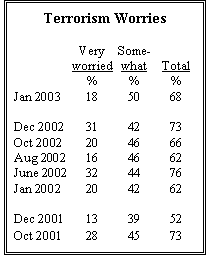
Anxiety about terrorism has been see-sawing for several months in response to news about international terrorist incidents and threats to the U.S. Overall concerns about a future attack have subsided somewhat, from 73% in December to 68%. The proportion very worried has fallen from 31% to 18%. By comparison, personal concerns over terrorism have remained more stable. About four-in-ten (41%) say they are at least somewhat concerned about becoming a victim of a terrorist attack; that figure has changed little since last January (38%).
No Democratic Frontrunner
Among announced and probable candidates for the Democratic nomination, Sen. Joe Lieberman is clearly the most recognizable name. But Sen. John Kerry receives, by a slight margin, the most favorable ratings among those who could give one. While fewer than half (46%) are familiar enough with Kerry to give him a rating, he receives more positive than negative assessments by roughly two-to-one (30% favorable, 16% unfavorable).
Fully two-thirds are able to rate Lieberman and the former vice-presidential candidate is, on balance, assessed favorably (39% favorable, 27% unfavorable). Rep. Dick Gephardt has similar visibility, and receives comparably favorable ratings.

Sen. John Edwards lacks the familiarity of some of the other candidates in the field, but has made a generally good impression on those who know about him. Just one-in-four Americans are familiar enough with Howard Dean to express an opinion about the former Vermont governor, and views are split among those who did (13% favorable, 12% unfavorable).
The only Democratic candidate with a negative public image is Al Sharpton. Six-in-ten Americans gave Sharpton a rating, and by more than two-to-one (42% to 18%) those ratings were unfavorable. Only African-American respondents view Sharpton more favorably (46%) than unfavorably (37%).
When the analysis is limited to Democratic registered voters, no candidate has a clear early advantage. Among those able to rate them, roughly three-quarters (74%) give Kerry, Edwards and Lieberman favorable reviews, and nearly as many (70%) say the same about Dick Gephardt. Only Dean and Sharpton trail the pack by this measure of partisan support.
Little Awareness of Candidates
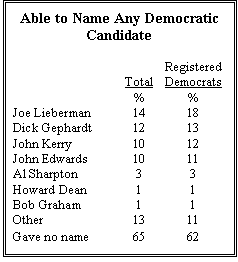
Only about one-in-three Americans could volunteer a name when asked to identify any of the Democratic candidates planning to run in 2004, and many of their answers were wrong, including references to Al Gore and Tom Daschle, who announced their plans not to run prior to the start of the survey. No candidate has a visibility advantage: 14% identified Joe Lieberman, 12% Dick Gephardt, and 10% could identify John Kerry and John Edwards as candidates.
While Democrats express more interest in news about who is and is not running for the party’s nomination next year, they are no more likely to be familiar with the names at this point than are Republicans and independents. Fully 62% of Democratic registered voters could offer no names when asked to identify any of the candidates. Lieberman is the best known, with 18% mentioning him as a potential candidate.
Powell Popular — Leading Democrats Not
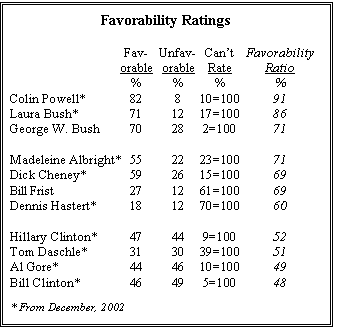
As has been the case since 1991, Colin Powell remains one of the most popular figures in American politics. Fully 82% rate Powell favorably, while just 8% feel unfavorably toward the Secretary of State. Powell is almost as popular among Democrats (80% favorable) as Republicans (91%). Only African-Americans are slightly more reserved about Powell; still, 69% view the Secretary of State favorably, while 19% give an unfavorable rating.
Both George and Laura Bush are viewed favorably by seven-in-ten Americans, but the president has a higher unfavorable rating (28%) than does his wife (12%). Personal evaluations of the president run far more favorably than assessments of his job performance. Democrats, on balance, disapprove of the president’s job performance by 55%-32%, but are split with respect to overall favorability (47% favorable, 52% unfavorable). And while 69% of independents rate Bush favorably, 57% approve of the job he is doing in office.
In general, Republican leaders receive significantly more positive evaluations than do Democrats. While most are not familiar enough with Sen. Bill Frist, the new Senate Majority Leader, to have an opinion, more rate him favorably (27%) than unfavorably (12%). Senate Minority Leader Tom Daschle is far more familiar to people, but receives mixed reviews (31% favorable, 30% unfavorable). Three of the most visible Democratic figures, Bill Clinton, Hillary Clinton, and Al Gore, are all viewed unfavorably by roughly half of those able to rate them. Former Secretary of State Madeleine Albright’s rating, however, remains high (55%).
Little Change on Roe v. Wade
Jan. 22 will mark the 30th anniversary of the Supreme Court’s landmark decision in the case of Roe v. Wade, which guaranteed access to abortion during the first trimester of pregnancy. The survey shows that a majority of the public (62%) does not want to see the decision overturned; 31% think it should be overturned. This division of opinion on the issue has been essentially unchanged over the past 14 years.
Opposition to overturning Roe is strongest among secular respondents (82%), liberals (78%), residents of the western U.S. (72%), unmarried women under 50 years of age (73%), and college graduates (71%). Overall, the views of men and women do not differ on the issue, and the views of white Catholics are not greatly different from those of the population in general: 36% favor overturning Roe, while 58% are opposed (see chart p. 12).
White evangelical Protestants are the only group in which a majority (55%) favors overturning Roe v. Wade. Among white mainline Protestants, only 22% think the decision should be overturned. Support for reversing the decision also is strong, but less than a majority, among conservatives (46%) and Republicans (43%).
Media Bias Complaints Rise

Despite strong support for the Supreme Court’s decision in Roe, a majority of the public (55%) feels that news organizations are one-sided in their coverage of abortion, while just 30% think the coverage is fair. The percentage seeing bias in coverage has grown by 12 percentage points since 1991, when 43% thought the coverage was one-sided and an equal number thought it was fair. White evangelicals (70%), conservatives (64%), and Republicans (64%) are the most likely to perceive bias, but even among those who oppose overturning Roe, 51% think coverage is tilted.
More see bias in the media as favoring those who oppose further abortion restrictions (30%) than those who favor such restrictions (16%). This perception of tilt in media coverage is also different from 12 years ago, when views about the direction of bias were evenly split.
Iraq, Economy Top News Interests
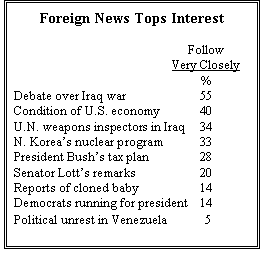
Debate over the possibility that the U.S. will take military action in Iraq continues to attract considerable public interest. More than half of Americans (55%) say they are following this news very closely, another 29% say they are following fairly closely. One-in-three are also following news about the work of United Nations weapons inspectors in Iraq very closely (41% fairly closely).
North Korea’s nuclear weapons program was of high interest to a third of the public, with another third following the story fairly closely. Men are significantly more interested in this news story than are women (39% and 27%, respectively, are following very closely).
But the public’s foreign news interest remains somewhat limited. Just 5% have closely followed news about political instability in Venezuela, and only 16% more say they have followed even fairly closely. Half (49%) have not paid any attention to this story at all.
The public’s interest in the condition of the nation’s economy has grown over the past year. Four-in-ten are following reports on the economy very closely, up from 30% a year ago. Attention to news of the president’s new tax plan is comparable to interest in Bush’s first tax reduction proposal he unveiled after taking office. Roughly three-in-ten (28%) are tracking news of the plan very closely, compared with 31% in February 2001.
One-in-five Americans closely followed Sen. Trent Lott’s resignation as Majority Leader after making racially-charged remarks in December. And this interest was only slightly higher among African-Americans (29%) than it was among whites (19%).
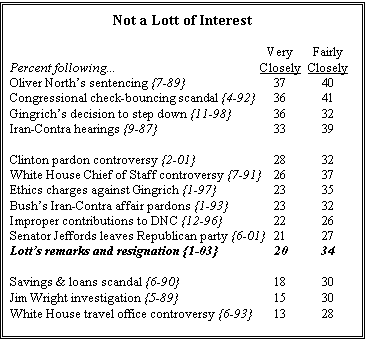
Compared to a number of other political scandals, interest in the Lott controversy was relatively low. Nearly twice as many (36%) followed Newt Gingrich’s decision to step down as Speaker of the House four years ago, and 28% followed the Clinton pardon controversy very closely two years ago. Lott’s decision raised about as much public interest as Senator Jeffords’ decision to switch parties in June 2001.
While younger Americans follow news less closely than their elders in most cases, the age gap is particularly noteworthy in stories about Lott’s remarks and resignation. Just 6% of those under age 30 followed this story very closely, compared to 34% of those age 50 and older.
The public showed little interest in the reports about a religious group that claimed to have successfully cloned a human being. Only 14% paid very close attention to these stories; a majority of the public (54%) paid little or no attention.




